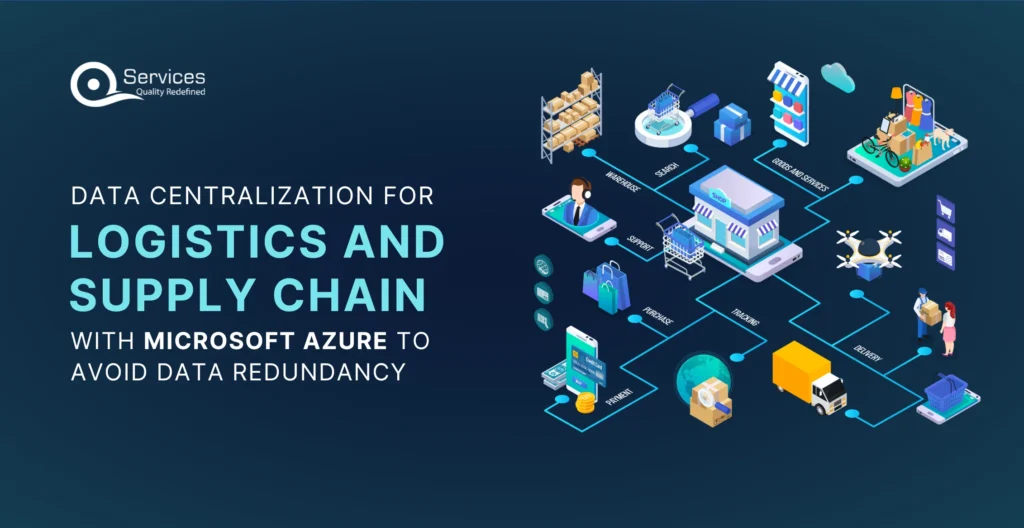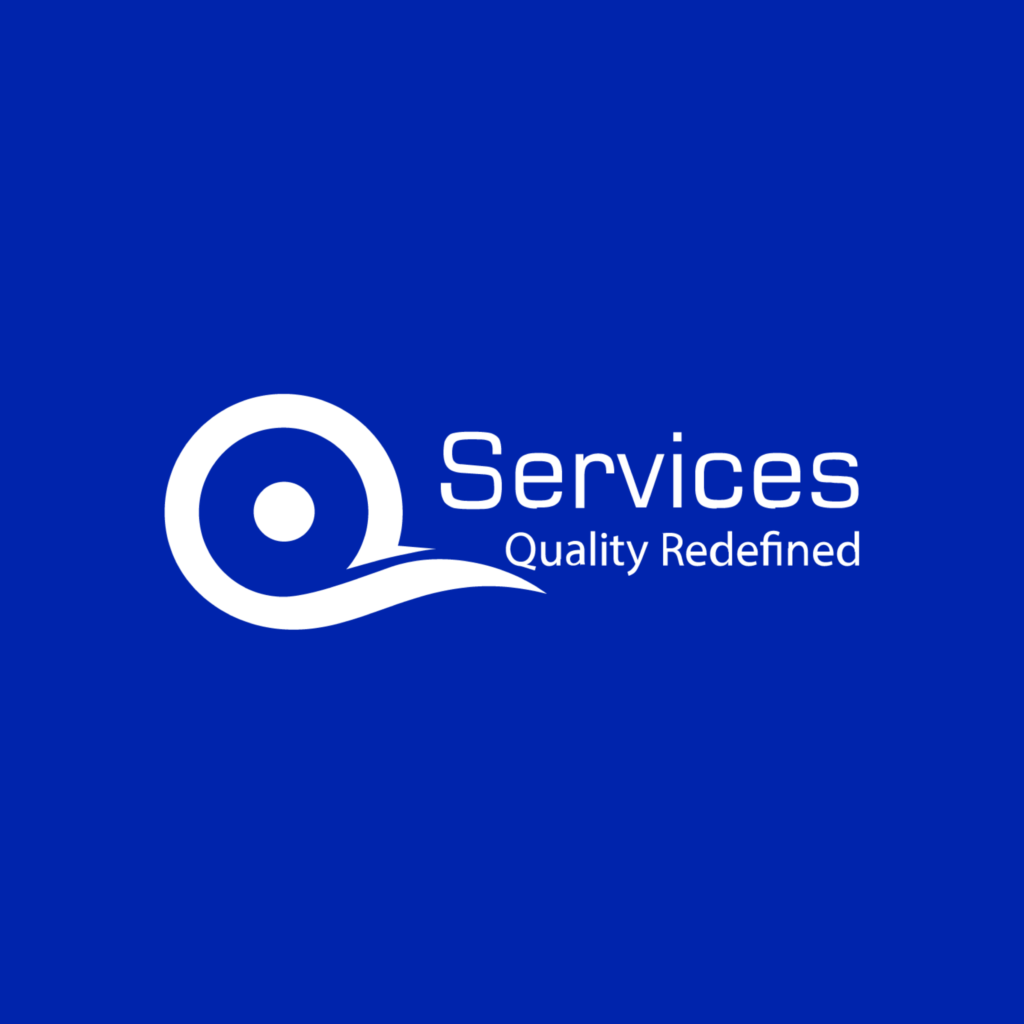
Home » Data Centralization for Logistics and Supply Chain with Microsoft Azure to avoid Data redundancy

We are talking about data centralization, but first we need to understand what it is. Centralized data means gathering all information in one place instead of having it spread out, which makes managing and accessing data easier and avoids data redundancy.
Supply chain and logistics face data redundancy issues from multiple systems storing duplicate data. This leads to inefficiencies, decision-making problems, and increased costs. To improve, integration and standardized data management are crucial for ensuring accuracy and coherence across the supply chain. In this blog, we will discuss how Microsoft Azure cloud services can alleviate these issues in the logistics and supply chain industries.
Inefficiency: Redundant data adds complexity to data management processes and can result in inefficiencies in inventory management, order processing, and transportation planning.
Inaccuracies: Inconsistent or duplicate data entries can lead to inaccuracies in inventory levels, shipment status, and financial records, which can impact decision-making and customer service.
Increased Costs: Managing redundant data requires additional resources, including time, labor, and storage capacity, which can increase operational costs and reduce profitability.
Risk of Errors and Delays: Redundant data increases the risk of errors and delays in supply chain operations, such as shipping the wrong products or quantities due to discrepancies in inventory records.
Companies often grapple with challenges related to data centralization. These challenges include:
Data Source Management: Bringing together scattered data from various sources can be akin to solving a complex puzzle.
Concurrency Handling: Managing multiple data tasks concurrently requires strategic coordination.
Simplifying Updates: Ensuring seamless updates across the centralized data platform can be intricate.
To address these challenges, organizations seek a unified data management platform like Microsoft Azure.
Get free Consultation and let us know your project idea to turn into an amazing digital product.
Data centralization is a powerful strategy that greatly boosts data management and slashes redundancy. Here’s how it operates, particularly within the Azure framework:
Centralizing data means consolidating it into one authoritative source. Instead of having data spread across various systems, it’s all gathered in one place. This ensures consistency and accuracy, minimizing redundancy.
With a centralized repository, organizations gain a comprehensive view of their data. Decision-makers access consistent and current information, enabling them to make better choices.
Centralization eliminates the need to search for data in multiple locations, reducing redundancy. Teams can swiftly locate necessary information, streamlining processes and boosting efficiency.
Protecting a single storage point is easier than securing scattered data. Centralized data allows for better control over access permissions, encryption, and monitoring, bolstering overall security.
Data centralization with Microsoft Azure, including Azure Database services, means services that bringing all your data together in one spot using Microsoft’s cloud platform called Azure. This helps you store, manage, and analyze your data more easily. With Azure, you can keep different types of data in one secure place and use various tools to work with it, like storing files or databases. This makes it simpler to understand your data and make smart decisions based on it.
Consolidating databases in Azure can lead to cost savings. By leveraging Azure’s pay-as-you-go model, organizations can optimize resource utilization and reduce infrastructure overhead.
Azure provides elastic scalability, allowing databases to grow or shrink based on demand. Centralizing databases enables efficient resource allocation and scalability planning.
Azure’s redundancy options, such as Availability Zones and Geo-Redundant Storage, enhance data availability and protect against regional outages.
Centralizing databases in Azure ensures consistent security policies, encryption, and compliance management across all data sources.

Azure Cloud Migration Services play a pivotal role in facilitating centralized data management. One of the core components within this suite is the Azure Database Migration Service (DMS), specifically crafted to streamline migration processes from various sources like SQL Server and open-source databases to Azure Data platforms. DMS offers a seamless migration experience, effectively minimizing downtime and automating essential migration steps. Furthermore, organizations can leverage the Data Migration Assistant to conduct comprehensive assessments of their databases. This tool provides insightful assessment reports, highlighting necessary changes and offering migration recommendations, thereby ensuring a smooth transition towards centralized data management within the Azure ecosystem.
Redundancy Options: Azure Storage provides different ways to ensure your data stays safe, like locally redundant storage (LRS), geo-redundant storage (GRS), zone-redundant storage (ZRS), and read-access geo-redundant storage (RA-GRS). Each option offers different levels of protection against things like hardware problems, data center issues, and problems in certain regions. This variety lets organizations pick the level of protection that fits their needs and how much risk they’re willing to take.
Data Centralization: Azure helps organizations gather their data in one organized place, creating a main hub for all information. This approach lowers the chance of having duplicate data and makes sure everything is consistent throughout the organization. By getting rid of scattered data across various systems, Azure makes managing data easier and cuts down on unnecessary repetition.
Azure Files and Blob Storage: Azure provides storage solutions that can grow with your needs, keep your data safe, and make sure it’s always available. With Azure Files and Azure Blob Storage, your data is automatically copied and backed up, so even if something goes wrong, you won’t lose it. This means you can trust that your data is protected from problems and interruptions, giving you peace of mind when storing your information.
Backup and Recovery: Azure offers strong backup and recovery services like Azure Backup, Azure Site Recovery, and Azure SQL Database Geo-Replication. These services help organizations protect their data by regularly making copies of it, duplicating virtual machines and applications to other places, and automatically copying databases to different regions. By using these backup and recovery tools, organizations can make sure their data is always available and safe, while also lowering the chances of having duplicate data.
Data Deduplication and Compression: Azure services employ data deduplication and compression techniques to optimize storage usage and minimize redundancy. By identifying duplicate data blocks and compressing them, Azure reduces storage costs and maximizes efficiency. This approach ensures that organizations can store their data more efficiently while minimizing redundancy.
Evaluate Data Sources: Begin by identifying all data repositories, including databases, files, and applications. Ensure compatibility with Azure services for seamless integration.
Develop Migration Plan: Craft a detailed strategy outlining the sequence of data migration. Prioritize data sets based on business importance and dependencies.
Utilize Azure Tools: Employ Azure Database Migration Service and choose appropriate storage options to simplify the migration process.
Ensure Data Security: Implement robust security measures during data transfer and storage. Leverage Azure’s security features to safeguard your data.
Optimize Data Transfer: Maximize data transfer speeds using Azure’s high-speed connections and optimization tools to minimize downtime.
Establish Data Management Guidelines: Define clear protocols for data handling and assign responsibilities to ensure compliance with governance policies.
Monitor Progress: Utilize Azure’s monitoring tools to track data movement and storage activities. Adjust your plan as needed to adapt to changing business requirements.
Understanding Your Supply Chain: Gain a thorough comprehension of your supply chain operations, spanning from procurement to product delivery. Identify pivotal data entry points and key stakeholders engaged in the process.
Identifying Critical Data Requirements: Pinpoint the essential information necessary to optimize your supply chain activities, including inventory levels and customer demand patterns.
Promoting Collaboration: Encourage collaboration among all stakeholders involved in the supply chain. Establish consensus on protocols for data sharing and standardize formats to enhance efficiency.
Ensuring Data Accuracy: Place a high priority on ensuring the accuracy and completeness of data. Rectify any discrepancies and uphold predefined standards for data quality to maintain reliability.
Establishing Data Governance: Define clear ownership rights and access permissions for different datasets within the supply chain. Outline specific rules and responsibilities for effective data management.
Integrating Data Sources: Implement strategies to consolidate data from diverse sources across the supply chain. Utilize integration tools to facilitate seamless communication between different systems.
Continuously Improving: Regularly assess the effectiveness of your data centralization initiatives. Utilize insights derived from data analysis to identify areas for enhancement and optimize overall supply chain performance.
Microsoft Supply Chain Platform: Microsoft introduces the innovative Microsoft Supply Chain Platform, aimed at revolutionizing supply chain design for agility, automation, and sustainability. This platform amalgamates cutting-edge Microsoft technologies such as AI, collaboration tools, low-code solutions, security features, and Software as a Service (SaaS) applications. It leverages building blocks across Microsoft Azure, Dynamics 365, Microsoft Teams, and the Power Platform to cater to specific supply chain requirements. With Dataverse integration, customers gain unparalleled visibility and actionable insights across their supply chain utilizing numerous data connectors.
Supply Chain Center: As an integral component of the Microsoft Supply Chain Platform, the Supply Chain Center empowers customers with a pre-built “command center.” Seamlessly interfacing with existing supply chain data and applications, it facilitates sustainable decision-making across various domains including product sourcing, package-free returns, transportation logistics, manufacturing, and warehouse automation.
AI-Powered Demand Forecasting: Microsoft Dynamics 365 Supply Chain Management delves into advanced AI-powered demand forecasting techniques. By integrating existing models, harnessing Custom Azure Machine Learning, and optimizing data hierarchy management, precision in demand planning is significantly enhanced.
AI Application in Supply Chains: Supply chains emerge as fertile ground for AI applications owing to their wealth of critical business data and processes. The strategic deployment of AI technologies within supply chains holds the potential to streamline operations, mitigate risks, reduce repetitive tasks, and elevate decision-making processes throughout the supply chain.
In summary, leveraging Microsoft Azure for centralizing data in logistics and supply chain management presents a robust solution to address data duplication challenges. Consolidating all data into a single repository enables companies to ensure data accuracy, streamline operations, and enhance decision-making. With the assistance of Azure’s comprehensive tools and services such as Azure Database Migration Service and Azure Backup, coupled with adherence to optimal data centralization practices, organizations can elevate the efficiency, adaptability, and responsiveness of their supply chain activities. Embracing Azure for data centralization not only resolves existing data redundancy issues but also positions businesses for future scalability and innovation. For deeper insights into enhancing profitability through logistics and supply chain optimization using cloud technology check out “The Role of Cloud Technology in Logistics and Supply Chain Optimization.”

Our Articles are a precise collection of research and work done throughout our projects as well as our expert Foresight for the upcoming Changes in the IT Industry. We are a premier software and mobile application development firm, catering specifically to small and medium-sized businesses (SMBs). As a Microsoft Certified company, we offer a suite of services encompassing Software and Mobile Application Development, Microsoft Azure, Dynamics 365 CRM, and Microsoft PowerAutomate. Our team, comprising 90 skilled professionals, is dedicated to driving digital and app innovation, ensuring our clients receive top-tier, tailor-made solutions that align with their unique business needs.

Traditional fraud detection methods often fall short in detecting today’s fraud intelligence. They rely on pre-set rules and struggle a lot. This is where the role of machine learning steps in. Using AI-powered fraud detection in banking is a smart way to deal with cyber threats.

The combination of Microsoft AI, Azure Health Insights, and Azure Cognitive Services is transforming healthcare by allowing smarter and efficient decision-making based on data. These technologies can fundamentally change the conventional practices of healthcare by taking new approaches to enhance

Healthcare is undergoing a massive shift thanks to new technologies. Think cloud computing, artificial intelligence (AI), and the tools developers use to build websites and apps. Hospitals and doctors’ offices are all trying to get better at caring for patients, running more smoothly, and keeping data safe. That’s why using Microsoft tech and Angular together has become a popular way to build modern, easy-to-use digital healthcare solutions.
Data centralization ensures that organizations have a single source of truth for their data. It improves efficiency, reduces redundancy, enhances reporting, and enables better decision-making.
Azure provides scalable storage solutions like Azure Data Lake Storage, seamless data migration with Azure Data Factory, and powerful analytics capabilities. It ensures data reliability, security, and accessibility.
In Microsoft Azure, Azure Databricks offers a unified analytics platform that simplifies data processing, transformation, and analysis.
Azure Storage regularly verifies data integrity using cyclic redundancy checks (CRCs). If data corruption is detected, it’s repaired using redundant data. Additionally, checksums are calculated on network traffic to detect data packet corruption during storage operations
Azure provides redundancy options such as Locally Redundant Storage (LRS), Zone-Redundant Storage (ZRS), and Geo-Redundant Storage (GRS). These ensure data availability and protect against failures.
Implement Azure Active Directory, use role-based access control (RBAC), encrypt data at rest and in transit, and regularly audit access to maintain security.
One can use Azure Monitor for monitoring, Azure Log Analytics for insights, and Azure Policy for governance. Regularly review logs and performance metrics.
INDIA : F-190, Phase 8B, Industrial Area, Sector 74,
Mohali, India
CANADA : 55 Village Center Place, Suite 307 Bldg 4287, Mississauga ON L4Z 1V9, Canada
USA :2598 E Sunrise Blvd, Fort Lauderdale,FL 33304,
United States

Founder and CEO

Chief Sales Officer
